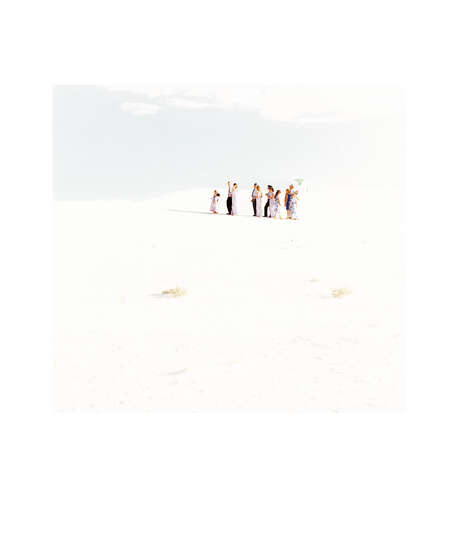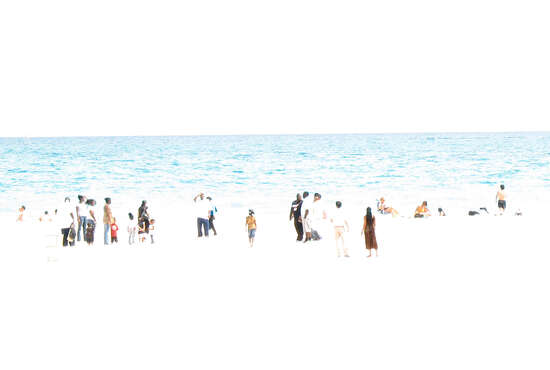READY TO HANG
Out of the box, all LUMAS artworks are ready and easy to hang.
SECURELY PACKAGED
LUMAS works are always packed to the highest standard to make sure it arrives as perfectly as it leaves us.
ARTIST SUPPORTED
Your purchase supports the free and independent work of your favorite artist.
14 DAY RETURNS
Easy 14 day returns to make sure you are satisfied with every purchase.
BACKGROUND INFORMATION
CUBAN BEACH & CUBAN CARS
In both of her new series, Cuban Beach & Cuban Cars, Julia Christe takes a refreshing and humorous look at life on the Caribbean island. At the same time, the artist stays true to her own unmistakable aesthetic, showing us her own view on the land and people that is far removed from the clichés, renowned street scenes and building facades that normally dominate our notions of Cuba.
Light and brightness play a decisive role in Julia Christe’s visual language. As in her previous series, White Sands & White Sands Beach, here on the Cuban beach, the earth and sky appear to merge fluidly. Little by little, the viewer discovers whimsical details in the sun-soaked, watery landscapes, the kind of details that subtly emerge to turn an idyllic scene into a typical Christe piece.
The artist captures Cuba’s world-famous, classic cars in an equally original way, photographing them with the sea in the background as the cars drive along the shore. The summer day’s bright, broad horizon creates a curious contrast to the crashing surf sweeping over the passing cars and their passengers.
With her humour, eye for details, and unique lighting instincts, Julia Christe manages to depict an extraordinary and vibrant side of Cuba – one that is off the beaten path.
WHITE SANDS
As far as the eye can see
With the weather acting up more and more, even the deserts do not remain pristine. Thus the new, and perhaps last chapter of Julia Christe’s „White Sands“ bears the name „White Sands Beach“. Massive rainfalls in the fall of 2006 transformed spectacular dunes into a lake district, and Christe set forth to intrude into this new landscape as far as to leave behind most visitors of the national park. „Where the American can’t drive, he doesn’t go“, her experience taught her.
In this sense she chose the locations of her new works, that are completely staged, excluding passersby. Taken in this irresistible scenery, the pictures’ tension arises from the clash of precise conception, mapped by the photographer before, and the surprises awaiting her on scene. This time Julia Christe did not rely on mere hazard, she did not wait for passersby, but brought her protagonists along with her and equiped them with curious accessories. The photographic results hold at times hidden and other times offensive humor, coming up with catwalk associations, little man’s pool idyll and surreal jugglery.
The open question on how tadpoles got into the newly emerged waters of White Sands not only busied biologists, Julia Christe too seems to have tranplanted it into her bizarre picture language: The presence of an Octoberfest-bavarian folk dance band from Garmisch-Partenkirchen remains an equally unsolved mistery as the origin of spawning frogs.Although the humorous note is much more developed than in the earlier chapters of White Sands, Julia Christes distinctive handwriting creates a special esthetic pleasure. Her purism is fatuating and the forlorn human figures become well set marks in the vastness of monochrome, vacillating plains.
MEETING POINT
Julia Christe always makes room for plenty of sky in her photographs, giving the strict grid an unending breadth and peacefulness, setting the stage for subtle irony and a subliminal unsettledness with stainless surfaces, which avoid extraneous sleekness.
Who’s walking around in these perfectly staged photographs? Who is the peculiar figure with a sombrero who creeps into Julia Christe’s new photographs? Whether on the American mainland, or in Australia or Hawaii, this entity, with its immense hat that reduces it to dwarf-like proportions, is always suddenly standing or crouching in the middle of grandiose landscapes as if it wants to take part in the natural experience. Sometimes it’s presenting a fish to a chorus line of pelicans; sometimes it’s perched on a withering tree looking out over our horizon. Hidden behind this odd figure is the continuous presence of the photographer herself who conspicuously resolves to capture the often grotesque affair between man and nature.
As a variation to her series “White Sands,” in which people, like peripheral phenomena at the American National Park on their way into the light or perhaps into the future, eventually disappear, Julia Christe staged this person as a small, penetrating other-worldly figure who is at the same time likeable and a bit annoying: nature gone awry, perhaps? At any rate, it is a running gag throughout world history.
REAL CHARACTER
In her series Buffalos, Julia Christe has dedicated her work to perhaps America’s greatest icon: the bison. She describes the beast as “massive, monumental and really old.” In a wintery Yellowstone National Park, she followed the tracks of the animal so important to Native Americans’ everyday life and religion. She specifically sought out historic terrain, since the national park founded in 1872 was an important refuge for the animals otherwise mercilessly hunted on the prairie. They embody the legends and drama of the unexplored half of the continent the settlers called the New World. Portrayed strictly in profile, they seem even more ancient. The heavy hooves deep in snow and the snow-covered scraggly fur and powerful chest are both archaic and majestic. America’s largest mammal, they have today again earned respect and a certain mythology. Christe’s photographs, often staged, reflect this transformation.
In Fabulus Julia Christe hopes to reveal the winter wilderness of Yellowstone as a fairytale world. In the foggy atmosphere animals like foxes and North American reindeer appear like mythical apparitions from out of the sparse landscape. In doing so the photographer masterfully simulates the ongoing yearning for an untouched and vast nature on a continent full of contradictory pulsing cities, endless highways, and expansive farms. The snow-white panorama perfectly accentuates the animals’ silhouettes. Here Christe continues to follow the same principle seen in her series White Sands: the blindingly bright background is practically her artistic signature.
FLYING DOGS & CATS
Amusing and extremely lovable are the protagonists in Julia Christe’s Flying Dogs & Cats series. Flying through the air, they endear the viewer with their wonderful facial expressions and gestures. Behind these lovely photos is a great deal of effort and finesse from the experienced photographer Christe, who has been working with her subjects since 2007. Shooting this series was challenging. Christe had to create a scenario that would allow the animals to briefly soar through the air without ever endangering their well-being or safety. On top of that, the animals had to fly within perfect view of the camera, with no disturbing objects in the shot. A park where dogs can jump high up in the air to grab a Frisbee was, for example, unsuitable. The solution was a photo shoot in a Berliner studio, where the animals and their owners were invited. They held their four-legged friends in the air and let them jump onto a soft mattress. The studio was an unusual environment for the animals. Initially, the were filled with surprise and curiosity –just as Julia Christe intended.
The inspiration behind the series was Christe’s dog Flinn, a Spanish water dog, and a bundle of energy and endurance. He loves to jump after Frisbees and other flying objects, freely and without a care for his landing. He enjoys his moment in the air, as if he were born to fly. As a photographer, Christe was moved to capture this brief moment of bliss. Soon after, she began preparing for her series.VITA
1973 Born in Tettnang 1994-2000 Communications Design at the GH-University Essen with Professor Bernhard Prinz Lives and works in Berlin Exhibitions
2008 Fofu, Fucecchio Foto Festival 2007 InterCity Berlin-Praha, Galerie Alte Schule, Berlin, Germany 2006 Realität oder was? (Reality or what?), Kunsthalle Aschaffenburg, Germany It’s Real!?, solo exhibition, Digital Art, Rödermark, Germany Summer Show, Schneider Gallery, Chicago, USA
Horizonte – Zeitgenössische Landschaftsfotografie (Horizons -Landscape in contemporary Photography), Lumas Europäischer Monat der Fotografie, Berlin, Germany Postfuhramt Berlin, Rodeo Club, solo exhibition, Germany 2005 Museum für Angewandte Kunst, Gera, Germany
Sehnsuchtsbilder, Sander Digital Pictures, Cologne, Germany InterCity Berlin-Praha, Galerie Manes, Prague, Czech Republic Fotosommer Stuttgart, Germany Lumas Editionsgalerie, Düsseldorf, Germany Lead Awards laureate, Deichtorhallen Hamburg Jesuit Church, Aschaffenburg, Germany Berliner Fotokunst in Prag (Berlin Photography in Prague), Czech Center 2004 Sehnsuchtbilder (Nostalgia Pictures) - Irrational Moments in Photography, Lumas Editionsgalerie, Berlin, Germany 2003
Kleurgamma, Unit, Amsterdam, Netherlands Ausstellung der Ankäufe 2002 des Bundesumweltministeriums in der Vertretung des Landes Nordrhein-Westfalens (Exhibition of purchases of the Environment Ministry), Berlin, Germany 2002 Photokina Visual Gallery, Cologne, Germany 2001 Reinhard Wolff Preis exhibition, Museum für Kunst und Gewerbe 1997 Bilderbad (Bath of Images), Herten, Germany Zeigung (Display), Zeche Zollverein, Essen, Germany










 No thanks, I would like to stay on this site.
No thanks, I would like to stay on this site. Yes, I would like to switch.
Yes, I would like to switch.